Bitcoin traders are being advised not to make impulsive decisions based on government sell-offs of BTC, according to a prominent analyst. Ki Young Ju, the founder and CEO of onchain analytics platform CryptoQuant, has downplayed the significance of recent state offloading. He argues that the amount of Bitcoin being sold by governments worldwide is minimal compared to the overall inflows into the space. Ki Young Ju highlights that while there have been nearly $250 billion in inflows since the latest bull market began, the funds that could potentially be sold by governments amount to less than $10 billion. He stresses that the government selling of Bitcoin is being overestimated.
This perspective offers a level-headed response to recent BTC price activity, which has been marked by sharp spot selling due to continued government selling and transfers from wallets connected to the now-defunct exchange Mt. Gox. Two countries of particular concern are Germany and the United States. Germany still holds 41,200 BTC that it seized from various criminals over the years, according to data from crypto intelligence firm Arkham.
While the Crypto Fear and Greed Index indicates that sentiment is approaching “extreme fear,” Ki Young Ju sees little reason to panic based solely on government actions. He points out that government sell-offs represent only 4% of the total cumulative realized value since 2023.
As market observers closely monitor key long-term support levels amid failed trendlines, there are concerns about the potential for further decline in BTC price. The supertrend floor at $52,000 is one of the closest support levels to the spot price. Calculations also suggest the possibility of a return to $45,000, which aligns with historical norms for drawdowns. However, the more traditional bull market support levels, such as the 200-day moving average and Bitcoin’s short-term holder cost basis at $58,550 and $64,175 respectively, are still well above the current spot price.
On July 5, BTC/USD hit four-month lows of $53,500. At the time of writing, it was trading around $3,000 higher.
It is important to note that this article does not provide investment advice or recommendations. All investment and trading decisions involve risk, and readers should conduct their own research before making any decisions.

